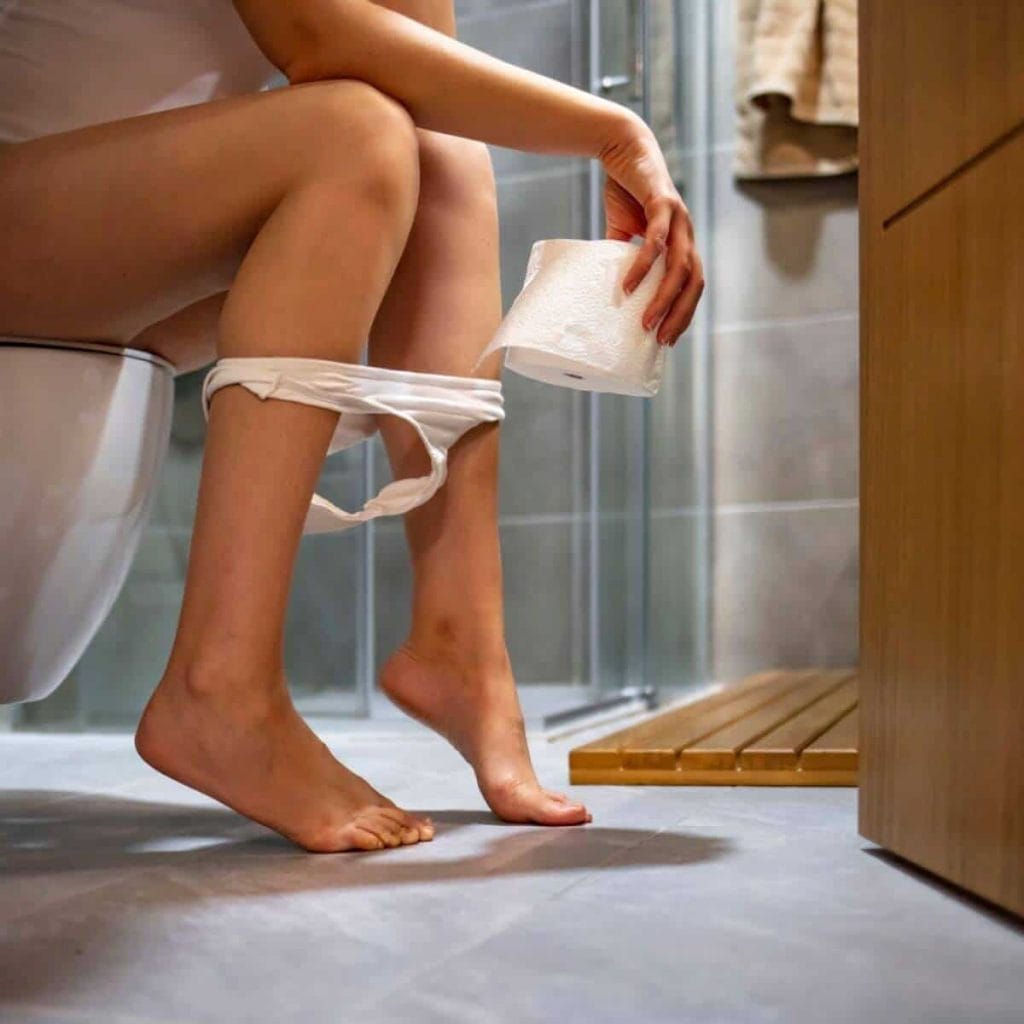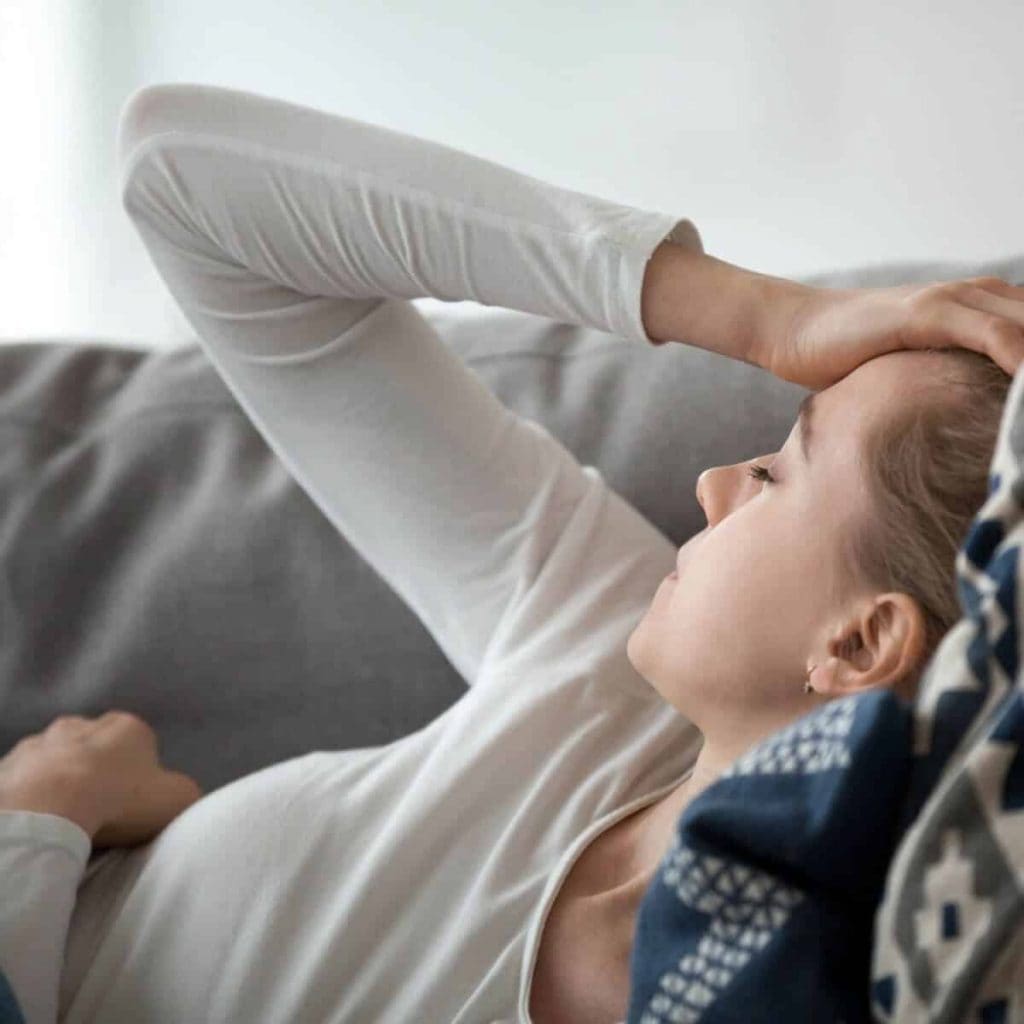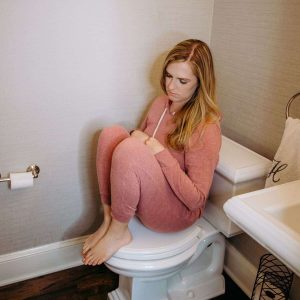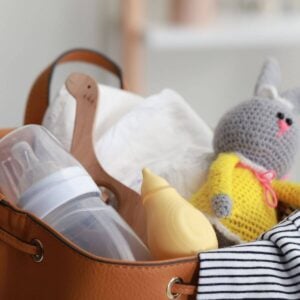A few weeks ago, I was watching a video by the hilarious Laura Clery. In it, she discusses all the random things you hear pregnant women bring up in conversation while carrying their babies. It’s no surprise that postpartum incontinence made the list.
While she covers a range of wild topics, such as nipple pain, lightning crotch, and figuring out how to choose a baby name, there’s a single sentence that pops up time and time again:
I peed a little.
I wish I could say that I didn’t understand the continual references to her weak bladder, but the uncomfortable reality is that I DEFINITELY identify.
As do most women who’ve carried a human inside their body.
Regrettably, while we might wish those little slips of urine would come to an end after our baby has joined us earthside, the truth of the matter is they often don’t. But they can, and we want you to know that.
Whether you’re dealing with mild postpartum incontinence or a complete loss of bladder control after childbirth, you’re not alone. Our pelvic floor muscles are significantly weakened during pregnancy, and just like the rest of our bodies, it takes work to get them back to shape.
Thanks to research into pelvic floor therapy, there are plenty of things you can do to get your pelvic floor back in tip-top shape and prevent those untimely “slips” from occurring. And there are things you can do to support yourself in the meantime.

This site contains affiliate links, meaning that we earn a small commission for purchases made through our site. We only recommend products we personally use, love, or have thoroughly vetted.
- What is Postpartum Incontinence?
- What Causes Incontinence After Pregnancy?
- Incontinence After Childbirth Statistics: How Common is this Problem?
- Do Some Women Experience Complete Loss of Bladder Control After Childbirth?
- Signs You Might Be Struggling with Postpartum Incontinence
- Solving Your Bladder Problems After Childbirth
- How To Keep Clean Underwear with Postpartum Incontinence
- It’s Time to Get Your Pelvic Floor Back in Shape
- More Postpartum Articles
What is Postpartum Incontinence?
As if the weird early pregnancy symptoms we deal with aren’t enough, bladder problems after childbirth seem to be par for the course. When you get down to the nitty-gritty of the situation, many women still find themselves wondering, “What is postpartum incontinence?”
Generally speaking, postpartum incontinence refers to leaking urine. Calling it a leak, however, doesn’t always cover it. Some women feel like they experience more of a “dribble,” while others struggle with a full release of urine.
There are three common types of incontinence after pregnancy:
- Stress Urinary Incontinence: This type of urine loss occurs when a woman exerts herself somehow: usually by exercising, running, laughing, sneezing, or coughing.
- Urgency Urinary Incontinence: Rather than spontaneous leaks, this type of postpartum incontinence describes more of an actual sensation. Women who deal with this have the sudden urge to use the bathroom and may leak on the way there.
- Mixed Incontinence: Just as it sounds, if you’re dealing with mixed incontinence, you’re struggling with both stress and urgency urinary incontinence.
What Causes Incontinence After Pregnancy?
It should come as no surprise, but the process of carrying and delivering a baby causes some *ahem* changes to your body…and why wouldn’t it?
After all, there was a literal human growing inside your abdomen.
To make more room for themselves (babies are greedy little creatures, aren’t they?), they tend to squish and flatten most of your vital organs. It would seem crazy to assume our bodies don’t have some type of negative response after all of that.
Since babies often like to use our bladders as pillows during their stays in Hotel Uterus, it makes sense that the added pressure would cause increased urinary urgency and leaks.
For most women, their bladder situation does return to normal within a few weeks of delivering their baby.
For others, the postpartum incontinence problems like to stick around on a more permanent basis, but why? What are the precise reasons that pregnancy and childbirth have such a severe effect on our bladders?
Here are four of the most common reasons women have to deal with incontinence after childbirth:
- Common “Wear and Tear”: Throughout pregnancy, our pelvic muscles become weakened and stretched. Many women recover from these changes quickly, but it can take others much longer, along with necessary work. Notice we call this experience “common,” and not “normal,” because while more women experience it than not, incontinence from pelvic floor struggles is not a normal bodily function and can usually be corrected.
- Pelvic Organ Prolapse: Occasionally, when a woman’s bladder becomes weak, it can slip out of position. This causes a condition known as cystocele that leads to postpartum incontinence.
- Pelvic Nerve Damage: If you dealt with a long and challenging vaginal delivery, there’s a chance the pelvic nerves responsible for your bladder can experience damage.
- Childbirth-Related Injury: Did your doctor have to use forceps or other intense delivery methods to birth your child safely? These can cause injuries to your anal sphincter and pelvic floor muscles. Another common delivery injury stems from prolonged pushing, which can cause damaged pelvic nerves.

Incontinence After Childbirth Statistics: How Common is this Problem?
Are you wondering how common this problem is?
You’re not alone because I was, too! Thankfully, some incredible scientists have researched the situation and have some eye-opening incontinence after childbirth statistics you should know:
- Approximately 4-in-10 women deal with urinary incontinence throughout pregnancy.
- Only around 10.1% of women who have never delivered a baby deal with urinary incontinence throughout their lives.
- About 15.9% of women who delivered via a cesarean section experienced postpartum incontinence.
- Nearly 21% of women who delivered vaginally struggle with bladder problems after childbirth.
- Women who deliver vaginally are 2 to 3 times more likely to have urinary incontinence problems than ones who’ve never delivered a baby.
- Approximately 5% of women still struggle with postpartum incontinence more than a year after childbirth.
Do Some Women Experience Complete Loss of Bladder Control After Childbirth?
Due to possible pelvic nerve damage and prolapsed organs, a complete loss of bladder control after childbirth may occur. If you’re struggling with near-constant urinary leaks, bedwetting, and extreme urgency, you should make an appointment with your doctor.
Signs You Might Be Struggling with Postpartum Incontinence
Aside from the occasional cough-pee or laugh-pee, there are some other signs that you could be dealing with incontinence after childbirth.
These include:
- A feeling of pressure in your pelvic area, causing a sudden need to pee
- Spasms in your pelvic area that can cause mild leaking or the urge to pee
- Needing to use the bathroom more than usual (more than eight times a day or twice at night)
- Wetting the Bed
- Inability to Hold Your Urine Before Reaching the Bathroom

Solving Your Bladder Problems After Childbirth
Often, bladder problems after childbirth will go away on their own once a your body has begun its postpartum recovery.
Other times, incontinence issues might stick around for the long haul.
It’s important to realize that postpartum incontinence is not a disease. Instead, it’s a symptom of something else. So to treat bladder problems after childbirth, the first thing you should do is figure out what’s causing them in the first place.
Always start your treatment by making an appointment with your doctor and expressing your concerns. But here’s the thing–not all doctors will recommend pelvic floor work, although many will. The fact of the matter is, pelvic floor therapy is growing in notariety and not all doctors are familiar with it.
We strongly recommend searching your local area for a pelvic floor physical therapist after birth. Or, if that’s not an option, there are tons of apps and website that help you learn about your pelvic floor, understand your personal struggles, and create a plan for fixing them. Our favorite is Every Mother, which is both a website and an amazing subscription-based app.
There are also exercises you can do at home. We’ll touch on those here, but we strongly recommend getting recommendations specific to your body whenever possible.
Kegels
Ahh, Kegels – the bread and butter when it comes to pelvic floor health. While there are certainly other pelvic floor exercises for incontinence, Kegels are always a great starting point for treating your postpartum body’s bladder problems if your problem is weak pelvic floor muscles. (Note that some women’s muscles are too tight, and some experts believe this can also contribute to incontinence. This is why we recommend personalized care plans whenever possible.)
If, by chance, you’ve missed the Kegels conversation before now, you might be wondering what they are and how to do them. Fret not, we’ve got you covered.
Kegels, also known as pelvic floor muscle training, work out your pelvic area to support your uterus, bladder, small intestine, and rectum.
One of the best things about Kegels is you can essentially do them any time, any place!
But, how do you do Kegels? Like this:
- Identify Your Pelvic Muscles: Before you start working out your pelvic muscles, you need to figure out what they are…how do you do this, you might be wondering? Simple, force yourself to stop peeing midstream! The muscles used for this action are your pelvic floor muscles.
- Use the “Marble Technique”: A great example of how to do a Kegel is to imagine you’re sitting on a marble. Then, tighten those pelvic muscles as if you were trying to lift that marble up. Once you have your imaginary marble lifted, hold that position for three seconds and then release for three seconds. Repeat.
- Stay Focused: Maintain your focus throughout each of your Kegels and try to avoid tightening other areas, such as your abdomen or buttocks.
- Try to Do Three Sets of 10, Three Times a Day.
Avoid Constipation
When we’re talking about bladder problems, you might assume anything poop-related wouldn’t be a part of the conversation. Strangely, though, they can go hand-in-hand.
As if your first postpartum poop wasn’t stressful enough, if you’re dealing with incontinence after childbirth, it’s essential to stay focused on preventing constipation.
After all, when you’re constipated, you end up struggling and pushing to poop. Unfortunately, all of this extra strain can lead to more postpartum incontinence trouble.
Losing Weight
Losing weight after childbirth isn’t just about fitting into your first postpartum swimsuit.
Extra weight, while completely normal (absolutely no judgement here, mama!!) can also play a role in treating your bladder problems after childbirth since extra weight can place increased pressure on your bladder and pelvic floor muscles.
Don’t stress about doing it immediately, but as you work to lose some of your pregnancy weight, you may also notice an improvement in bladder leakage.
Pelvic Floor Exercises for Incontinence
In addition to Kegels, experts believe that many different exercises and stretches can help strengthen your pelvic floor. Based on information from a professional trainer, some of the most popular ones include:

Medical Treatments
If some of these more homeopathic options don’t work, it might be time to consider medical treatments with your doctor to resolve your postpartum incontinence.
There are several different surgical and nonsurgical options available, such as:
- Botox (Yes, you read that right!)
- Medications
- Sling Procedures
- Nerve Stimulation
How To Keep Clean Underwear with Postpartum Incontinence
For some women, postpartum incontinence only strikes occasionally–say, when jumping on a trampoline. For others, it’s an everyday problem.
Our founder, Katy, for instance, didn’t realize she had postpartum incontinence because she never felt urine release. But for some women, like Katy, there’s a release you can’t feel, but can see in your underwear when you go to the bathroom.
Whether you feel that you’re peeing a little or not, wet underwear can feel upsetting, uncomfortable, and can develop an unpleasant stinch. And mama, we don’t want that for you!
So while we strongly recommend getting support for your pelvic floor, we do want you to know there are things you can do while you’re working to improve your incontinence.
Did you know that there’s underwear made specifically for bladder leakage? There is, and we LOVE it! It’s great as pregnancy underwear, postpartum underwear, or everyday wear while you’re working to improve your bladder leakage.
Have you heard of period panties? Thinx, the most popular period panties on the market, also makes some specifically designed for urinary leakage. They’re called Speax, and we swear by them.
Try Speax risk-free for 60 days!These panties are absorbent enough that you’ll never feel wet, so you can wear them comfortably all day. They’re comfortable and machine washable, so wear them just like you’d wear regular panties.
It’s Time to Get Your Pelvic Floor Back in Shape
Let’s face it; most of us don’t want to deal with bladder problems after childbirth. I mean, really, how enjoyable is it to worry about peeing yourself every time you laugh or sneeze?!
Thankfully, there are plenty of easy ways to treat your incontinence after pregnancy.
Whether you’re thinking about trying pelvic floor exercises like Kegels or medication, bringing an end to your pelvic floor trouble might not be as difficult as it seems.
So, if you’re tired of those little slips and dribbles, why not give one of these great tips a try?
If you’ve had to deal with postpartum incontinence in the past, how long did it last? How did you treat it?









